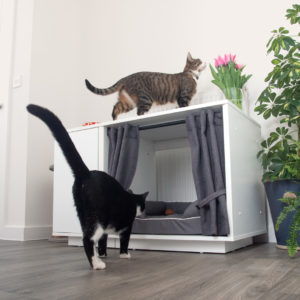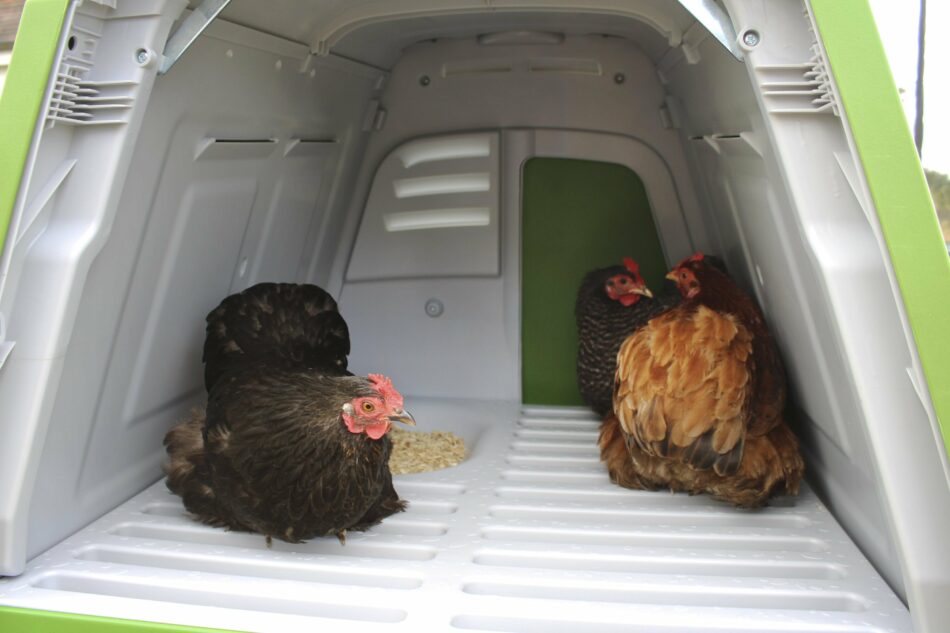
A cat’s signature move is the slinky walk with an upright tail. Intriguingly, no other cat species walks like this, and it is not known exactly when pet cats first adopted the posture.
The domestic cat’s ancestor, the African wildcat, hooked up with humans more than 10,000 years ago. They probably adopted us, rather than the other way round, attracted by the surplus of rodents nibbling away at our grain stores. It seems pretty certain that the feline freeloaders soon adapted their body language – tails included – just to please us, quickly securing their place on the sofa.
The following cat-of-nine-tails facts tell you everything you need to know about your pet cat’s swishing tail.
1 – Balancing Act
Cats have fantastic balance. Their tails play a major role in this skill, acting as a counterweight when puss is ‘tightrope walking’ on narrow walls or ledges. The tail also helps cats run and change direction with great agility – and without stumbling. Next time you get the chance, watch a cat run and turn – if a human took some of those feline twists and turns at a similar pace, they would simply fall over.
2 – Tails Tell Tales
Cats communicate with their tails, sending out subtle signals. The most familiar signal is the upright tail, a sign of a happy cat. In moments of great pleasure, the upright tail will quiver at the tip. This is not to be confused with the twitching tail of a resting cat, which means she’s irritated. Once the cat is on her feet and the tail is swinging from side to side, she’s switched from annoyance to anger, so watch out!
3 – Let us Prey
When they’re stalking prey, cats tend to keep their tails low and still, but they may still flick and twitch in excitement as the moment of pouncing draws near. If the hunt is unsuccessful, the tail will twitch restlessly in irritation.
4 – No Tail to Tell
Some breeds, including the Manx, are born without tails, due to a dominant gene. Two tailless Manx cats should never be allowed to breed, however, as a combination of the two dominant genes brings severe health problems to the kittens. The curly tail of the Bobtail breeds doesn’t come with the same potential health problems as the Manx cat gene. Both the Manx and the Bobtails seem to have learnt to balance pretty well without a classic cat tail.
5 – When the Tail Goes Cold
A cat that has lost its tail in an accident, or has injured it in a door or traffic accident, is definitely handicapped. It will not be able to balance as well as before or send out those tail-twitching signals. It is still capable of leading happy life, though – owners just have to look for other body language details to read their pet’s mood.
6 – Inside Story
Cat’s tails have between 19 and 23 vertebrae, depending on the breed (and not counting the tailless Manx!) This represents around 10% of the total number of bones in the cat’s body. These vertebrae give the tail its whiplash flexibility, held together with complex muscles, tendons and ligaments.
7 – Ailing Tails
If your cat is feeling unwell, you can usually see the signs in its tail. It won’t be held upright or twitching excitedly like before. If you notice that the behaviour of your pet’s tail has changed, take it as a sign that she needs a health check. Some cats are prone to dermatitis, sometimes brought on by fleas. This can often be seen in inflamed areas in the region where the tail joins the rump. Some hormonal problems can result in inflammation in the tail too.
8 – Upstanding Felines
The ability to walk with an upright tail is actually unique to domestic cats. All other members of the cat family walk with the tail down, horizontal, or tucked safely between the legs.
9 – Tail End
Cats raise their tails to tell us they’re happy and relaxed, but when prowling amongst other cats the raised tail signal is an invite to come and investigate. Other cats will sniff a cat whose tail is in the air.
It is widely thought that purring is something cats invented just for us – and perhaps that upright happy tail is another one of the ways they won a place in our hearts and homes.
This entry was posted in Cats on June 10th, 2020 by linnearask

Most hens lay their eggs with minimum fuss. They might make a bit of noise to announce their egg-laying achievement but will soon return to the daily business of exploring and scratching for food. Some hens, however, do make a bit more fuss. To be more accurate, these hens are known as broody. A broody hen is one who sits on her egg with every intention of staying there until it has hatched – no matter whether the egg is fertilised or not. This is very useful if you want to hatch some chicks, but otherwise, it can be a problem. So then, how do you stop a hen from being broody?
The cause of broodiness
The cause of broodiness is linked to body heat, backed up by maternal instincts. Hens who are cooped up together in a hot henhouse may suddenly heat up to a level that makes them think “I’m going to hatch an egg!”. Certain chicken breeds seem more susceptible to broodiness than others, with the Silkies and Cochins being particularly moody-broody.
Signs of broodiness
A broody hen undergoes a personality change. The most obvious sign of this is her refusal to leave the nesting box. She’ll sit there with the air of a bird who will happily wait until Doomsday for the egg to hatch. This misplaced dedication will also make her grumpy and liable to peck or cluck angrily if you try to move her.
When you do manage to oust her from the box, she’ll simply head back there again and resume her brooding. Once she feels established in her new maternal role, she will fluff out her feathers and may begin to self-pluck her chest feathers to line the nest.
How to stop a hen from being broody
Time to get moving
Appearances can be misleading. Your hen may look as though she’ll sit in the box for eternity, but in reality, she’ll only stay there – usually – for three weeks. This is the length of time it takes a chicken egg to hatch. This means, if space allows, you can simply let her brood for 21 days, and once the mood lifts, she’ll return to business as usual. But, if you don’t have a cockerel and don’t want to rear your own chicks, this can be frustrating and you’ll want to break your hen from her broodiness.
You also need to make sure your hen gets enough food and drink during this time, which can be difficult for a hen who doesn’t want to leave their nesting box. This may involve forcibly removing her from the box and shutting it off until she has taken refreshments. Be sure to collect any eggs immediately when you do get the opportunity and be sure to always wear sturdy gloves as a precaution when attempting to move any broody hen. This will prevent your hands from getting pecked!
Try frozen veg
A common anti-broody trick is to place a packet of frozen peas or sweetcorn kernels wrapped in a blanket or tea towel underneath the hen in the nest box. Crushed ice cubes in a bag will do the trick, too. This has the dual impact of cooling the chicken down and making life in the nest box too uncomfortable for brooding.
Nest box obstacle course
Sometimes a simple obstacle such as a plant pot or a couple of bricks will have the desired effect. If the hen can’t access the nest box, she can’t sit there and brood. Fortunately, the Eglu Cube chicken coop has a central divider with a sliding door, which means you’re simply able to close the nest area off from the rest of the coop.
Set up a broody enclosure
Some chicken keepers use a so-called “broody enclosure” to break the habit. This is a wire cage or crate, in which the chicken is placed along with food and water. After three days, this gentle form of solitary confinement will usually break the broody habit. The signs that the brood mood is over are obvious – the hen will stop fluffing out her feathers and will stalk around the cage, rather than sitting and brooding.
Fancy chicks?
Then again, you could purchase some fertilised eggs and let the broody hen resume as she was. If you do want chicks, this is by far the easiest, and most natural way of producing them – under the fluffy belly of a broody hen.
Omlet and your hens
At Omlet, we design products that help find solutions to all your pet questions, like what’s the best coop for a broody hen? With unique products like the Omlet Eglu Cube chicken coop and Walk In Chicken Runs, our expert designers strive to continue creating the best environments for all pets – feathered or furry.


This entry was posted in Chickens on June 10th, 2020 by linnearask




